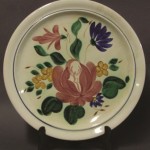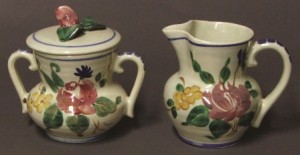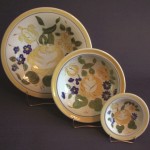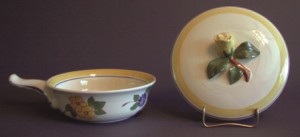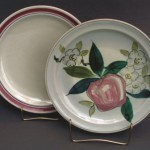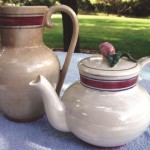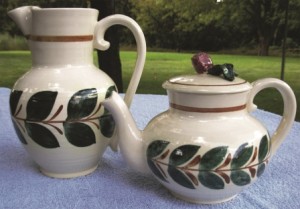The information presented here has been taken from the RWCS Newsletter Introduction to Dinnerware article series. Below is a brief summary of the early patterns by Red Wing.
Each pattern has been assigned an Availability rating and a Collector Interest rating as described below. Availability represents an average for the pattern in question, however the scarcity of certain pieces within the pattern may differ. Collector Interest refers to the pattern in general, but there may be specific pieces in any pattern that are of greater interest to specialty collectors (teapots, pitchers, salt & peppers, etc). Please keep in mind these ratings are the authors’ observations; your experience may vary.
| AVAILABILITY | COLLECTOR INTEREST |
| 1 Rare | 1 Highly sought, demand exceeds supply |
| 2 Very scarce | 2 Primarily of interest to specialty collectors |
| 3 Hard to find | 3 Above average |
| 4 Average | 4 Average |
| 5 Readily available | 5 Below average |
The Full Article includes where the information was found, availability and collector interest for the patterns.
Normandy (early) Availability: 1 Interest: 2 Years: 1941 – 1941 or 1942
Ardennes (early) Availability: 3 Interest: 3 Years: 1941 – mid 1940s
Orleans Availability: 5 Interest: 3 Years: 1941 – 1950
Brittany Availability: 4 Interest: 4 Years: 1941 – 1950
Normandy (late) Availability: 4 Interest: 4 Years: 1949 – 1952
Ardennes (late) Availability: 3 Interest: 4 Years: 1949 – 1951
In 1941 Red Wing introduced their first hand painted dinnerware patterns under the direction of newly hired designer Charles Murphy. Except for a brief break in the early 1950s, Murphy served as Red Wing’s primary dinnerware designer from this time until the business closed in 1967.
The Provincial shape was introduced in 1941 and included four patterns. Orleans featured a red rose with smaller blue and yellow flowers and green leaves against a white background. The Brittany design was similar but with a yellow rose along with smaller blue and yellow flowers and green leaves with a white background. Both Orleans and Brittany were popular and continued in production essentially unchanged until 1950. But the initial versions of Ardennes and Normandy did not sell as well. The original Normandy design did not feature an apple; it consisted of only blue and maroon bands on a white background. This version was produced very briefly, probably for no more than a year, and is very difficult to find today. The original Ardennes featured a ring of green laurel leaves on white base on all pieces (including hollow ware); this version was sold until 1945 or 1946. The knobs on the various covers for all four of these patterns were in the shape of a rose.
In 1949 Normandy and Ardennes were reintroduced with significant changes. Normandy flatware (plates and bowls) now had a big red apple in the center. For the most part Ardennes flatware was unchanged but the artwork was sharper and different shades of green and brown were used. Hollowware for both patterns was available in two solid colors, Dubonnet (maroon) or Forest Green. Covers for updated Ardennes and Normandy pieces have a leaf-shaped handle rather than the rose knob found on the earlier versions and on Orleans and Brittany.
Several new items for the Provincial line were introduced in the late 1940s. The gravy boat was made for all four patterns but Orleans and Brittany gravy boats are comparatively rare because they were made for only a brief period. Beverage servers and 8 inch coupe soup bowls were added for updated Normandy and Ardennes but were not made for Orleans or Brittany. In 1951 spoon rests were added for all patterns currently in production. Because Orleans and Brittany had been discontinued by that time no spoon rests were made. Normandy spoon rests were included on a August 1951 price list and have been found, but the status for Ardennes is not clear. The August 1951 price list excluded the Ardennes pattern. But a retail ceiling price booklet with the same August 1951 date included Ardennes and listed a spoon rest. The authors have not seen an Ardennes spoon rest so if they exist they are rare.


